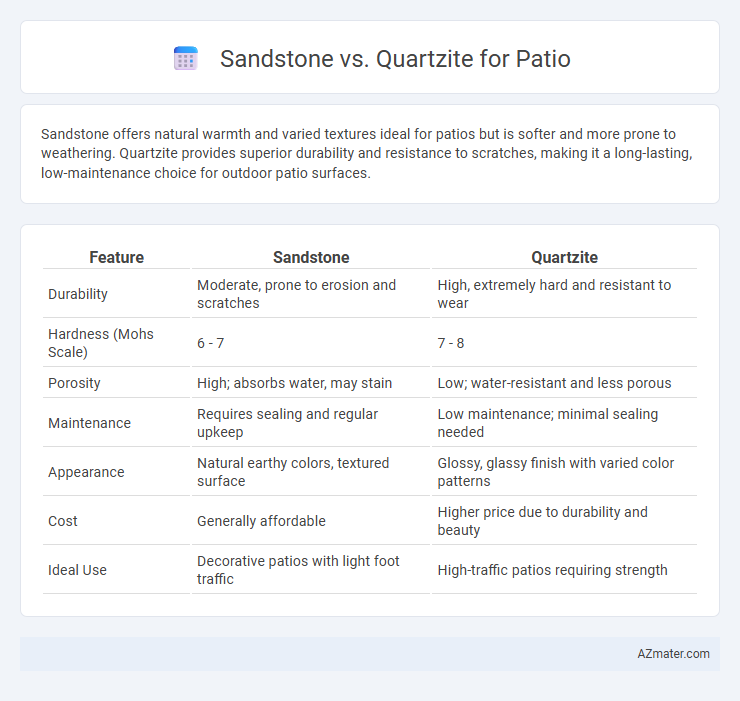Sandstone offers natural warmth and varied textures ideal for patios but is softer and more prone to weathering. Quartzite provides superior durability and resistance to scratches, making it a long-lasting, low-maintenance choice for outdoor patio surfaces.
Table of Comparison
| Feature | Sandstone | Quartzite |
|---|---|---|
| Durability | Moderate, prone to erosion and scratches | High, extremely hard and resistant to wear |
| Hardness (Mohs Scale) | 6 - 7 | 7 - 8 |
| Porosity | High; absorbs water, may stain | Low; water-resistant and less porous |
| Maintenance | Requires sealing and regular upkeep | Low maintenance; minimal sealing needed |
| Appearance | Natural earthy colors, textured surface | Glossy, glassy finish with varied color patterns |
| Cost | Generally affordable | Higher price due to durability and beauty |
| Ideal Use | Decorative patios with light foot traffic | High-traffic patios requiring strength |
Introduction to Sandstone and Quartzite Patios
Sandstone patios are popular for their natural warmth, earthy tones, and porosity, which allows for easy drainage and slip resistance. Quartzite patios offer exceptional durability and a dense, non-porous surface, making them resistant to stains and weathering. Both materials provide aesthetic appeal but differ significantly in hardness, maintenance, and long-term performance for outdoor spaces.
Key Differences Between Sandstone and Quartzite
Sandstone is a sedimentary rock composed mainly of sand-sized mineral particles, offering a softer texture and porous surface ideal for natural, rustic patios but requiring regular sealing to prevent weather damage. Quartzite, a metamorphic rock formed from sandstone under intense heat and pressure, boasts exceptional hardness and durability with a non-porous, glassy surface that resists staining and erosion, making it a premium choice for high-traffic outdoor areas. Key differences include quartzite's superior strength, lower porosity, and higher resistance to wear compared to sandstone's greater ease of cutting and more affordable pricing.
Durability and Strength Comparison
Quartzite exhibits superior durability and strength compared to sandstone, making it more resistant to scratches, chips, and weathering for patio use. Its natural hardness, often exceeding 7 on the Mohs scale, helps withstand heavy foot traffic and harsh environmental conditions. Sandstone, while aesthetically pleasing and more affordable, is softer and more porous, requiring regular sealing to prevent damage and ensure longevity outdoors.
Aesthetic Qualities and Color Options
Sandstone offers a warm, natural appeal with earthy tones like beige, tan, red, and brown, ideal for rustic or traditional patios, while quartzite provides a sleek, polished look with vibrant colors ranging from white and gray to green and pink, suited for modern designs. Quartzite's subtle shimmer and fine-grain texture create a sophisticated surface that is more resistant to fading and weathering compared to sandstone's softer, porous structure. Patio designers often choose quartzite for its durable, glossy finish and diverse color palette, whereas sandstone remains popular for its rugged charm and organic hues.
Slip Resistance and Surface Texture
Sandstone offers a naturally rough surface texture with excellent slip resistance, making it a safe choice for patio areas prone to moisture. Quartzite features a harder, denser surface that can be polished smooth, reducing slip resistance but providing a sleek, modern appearance. For outdoor patios, selecting sandstone ensures better traction and safety, while quartzite may require textured finishes or treatments to improve grip.
Weather and Climate Suitability
Sandstone offers excellent weather resistance in mild to moderate climates but may absorb moisture in heavy rainfall, leading to potential erosion or discoloration. Quartzite exhibits superior durability and resilience against extreme weather conditions, making it ideal for areas with harsh winters, heavy rain, or intense sun exposure. For patios in regions with fluctuating temperatures and high humidity, quartzite ensures long-lasting performance with minimal maintenance compared to sandstone.
Maintenance and Cleaning Requirements
Sandstone patios require regular sealing and gentle cleaning with mild soap and water to prevent staining and erosion due to their porous nature. Quartzite, being denser and harder, demands less frequent sealing and can withstand power washing without damage, making maintenance simpler and more durable over time. Both materials benefit from prompt removal of debris and spills to maintain their aesthetic appeal and longevity.
Installation Process and Costs
Sandstone patios offer easier installation due to their softer texture, allowing for simpler cutting and shaping, which reduces labor costs. Quartzite, being much harder and denser, requires specialized tools and experienced installers, increasing both installation time and expense. Material costs for quartzite are generally higher, while sandstone provides a budget-friendly option with moderate durability.
Environmental Impact and Sustainability
Sandstone is a naturally occurring sedimentary rock with a lower environmental footprint due to minimal processing requirements, making it a sustainable choice for patios. Quartzite, formed from metamorphosed sandstone, demands higher energy consumption in extraction and finishing processes, which can increase its environmental impact. Both materials are durable and long-lasting, contributing to sustainability by reducing the frequency of replacements in patio applications.
Which Is Better for Your Patio: Sandstone or Quartzite?
Quartzite offers superior durability and resistance to weathering, making it an ideal choice for patios exposed to harsh climates. Sandstone, while aesthetically pleasing with its natural, warm tones, is softer and more porous, requiring regular sealing to prevent staining and erosion. For a long-lasting, low-maintenance patio, quartzite is generally the better option due to its hardness and minimal upkeep needs.

Infographic: Sandstone vs Quartzite for Patio
 azmater.com
azmater.com